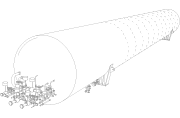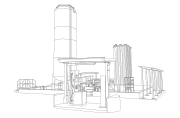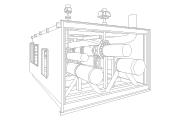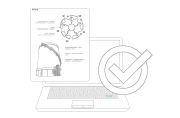Imagine freezing materials in seconds with zero compromise to quality. This is exactly what liquid nitrogen freezing offers: a true revolution in preservation techniques that is reshaping sectors where instant freezing guarantees better results, from food preservation to biotech processes.
Cryogenic freezing via liquid nitrogen offers unmatched advantages, but it also requires specialized equipment and safety measures. From our expertise in cryogenic engineering, we share some of the keys to understand liquid nitrogen freeze and how to apply it successfully.
Liquid nitrogen freezing: how it works and why it matters
Liquid nitrogen freezing refers to the process of rapidly freezing materials by exposing them to liquid nitrogen’s extremely low temperatures. As such, liquid nitrogen freeze can be understood as part of cryogenic freezing techniques, which are based on using extremely low temperatures to preserve materials.
This is possible thanks to nitrogen’s boiling point, which is -196 °C (-321 °F). In order to produce this element, nitrogen present in the atmosphere is liquefied (cooled) and then preserved in specialized cryogenic dewars.
You might be interested: Liquid nitrogen storage: Key factors for safety and efficiency
Its low temperature is what enables this substance to act as a uniquely efficient cooling agent, allowing for precise and fast freezing. More specifically, liquid nitrogen freezing consists of exposing materials like food or biological samples to this substance. This way, they absorb the cold from LN₂, experiencing a quick drop in their temperature.
How does liquid nitrogen freezing differ from conventional freezing?
Liquid nitrogen freezing is markedly different from conventional freezing in one crucial way: it allows for instantaneous freezing. This quick freezing significantly affects the way materials react to the process, having important consequences in terms of texture and structure.
Looking at conventional freezing processes offers more clues about the advantages of liquid nitrogen freezing. Conventional methods involve temperature ranges of -18°C / 0°F, and require items to be cooled over a period of minutes or hours. During the process, large ice crystals are formed inside the material, which can rupture cell walls and cause changes and degradation in terms of texture and structure.
On the contrary, liquid nitrogen freeze takes place in much lower temperature ranges (~ -196°C) and is extremely quick. This prevents the formation of large crystals, and thus preserves the material’s texture.
Cryogenic liquid nitrogen freezing in the food and biotech industries
Applications in food preservation
Liquid nitrogen’s capacities for ultra-fast freezing are useful for preserving a wide range of food products, but it is particularly useful for delicate items that are challenging to freeze using conventional methods, from fruit to seafood and gourmet items.
Keep learning: Cryogenic food processing: what it is and its characteristics
The freezing process almost completely halts microbial and enzymatic activities, extending the products’ shelf life while preserving their texture, taste and nutritional value. Additionally, it can be employed for Individual Quick Freezing (IQF) processes, so that each item is frozen separately and rapidly, rather than in a block or cluster.
Aside from freezing, liquid nitrogen is also employed in various processes across the food industry, including cryogenic grinding, food packaging, ice cream production or freeze drying.
Applications in biotechnology and life sciences
Liquid nitrogen freezing is opening new, fascinating opportunities in the fields of biotechnology and the life sciences in general.
Its ultra-fast freezing capacities are fundamental to maintaining cellular integrity and thus preserving delicate biological tissues. As such, liquid nitrogen is employed for cell cryopreservation and storage, as well as safe transportation of items such as vaccines and other medicines, genetic samples and biological products.
Beyond preservation, there are also a number of processes that are employing liquid nitrogen in the life sciences thanks to this substance’s capacity to keep molecules stable and avoid chemical degradation. For instance, it has opened the door to a number of biomedical sample processing techniques, including tissue fractionation, cell disruption or sample preparation.
Benefits of cryogenic freezing for both sectors
Contact with extremely low temperatures allows for instant cryogenic freezing which, in turn, opens the door to a series of advantages:
- Avoiding damage to the internal structure of materials
- Preserving quality, texture, nutrients and/or biological viability
- Better preservation and reduced oxidation and microbial growth, because fast freezing limits exposure to air and moisture during the process
- Scalable procedures for both industrial and laboratory environments, as the freezing procedures can be adapted to various volumes
- Granular control and precision over the freezing process

Liquid nitrogen: safety and best practices for freezing processes
Key safety precautions when handling liquid nitrogen
The extremely cold temperatures of liquid nitrogen can make it a dangerous element when safety precautions are overlooked, as it can cause cold burns, frostbite and damage to eyes.
Additionally, potential leaks can lead to oxygen deficiency in atmospheres and risk of asphyxiation, while pressure buildup is a potential source of explosions.
According to these risks, safety precautions when handling liquid nitrogen include:
- Liquid nitrogen should be stored in well-ventilated areas
- Ventilation protocols must be applied to avoid risks related to leaks
- Pressure-relief devices in cryogenic containers and monitoring systems for pressure should be adopted to avoid potential pressure buildup
- Use only approved cryogenic containers for storage
- Human teams should be trained on how to handle liquid nitrogen safely and be provided with the right personal protective equipment. This includes face masks, safety glasses, thermally insulated gloves and appropriate clothes and safety shoes.
Keep reading: Cryogenic equipment: examples, uses and how to choose the right supplier
Challenges and best practices in implementing liquid nitrogen freezing
- Delivery and storage costs and protocols can represent a challenge. To minimize its impact, the right partner for supply should be identified that is capable of maximizing efficiencies across these processes.
- Storage systems (like Dewars or cryogenic tanks) require investment and ongoing maintenance. Choosing high-quality, low-maintenance equipment and suppliers that offer reliable support can make a difference to overcome this challenge.
- While liquid nitrogen is a relatively affordable element, precision during its use will avoid unnecessary waste and maximize cost-effectiveness.
- In the case of cell preservation, precise control over freezing rates is necessary to ensure cell viability after freezing, because different cells have varying freezing rate requirements. Advanced tools for liquid nitrogen freezing must be adopted in order to guarantee the maximum precision and control during the process. Additionally, freezing techniques should be tailored based on the specific material type, in order to preserve its integrity.
Cryospain: experts in cryogenic engineering and your allies for liquid nitrogen freezing
At Cryospain we put our cryogenic engineering expertise at the service of companies looking to elevate their liquid nitrogen freezing capabilities.
Find out one of our projects: Cryogenic Tank for nitrogen storage in Brazil
As part of our cutting-edge cryogenic storage equipment, we offer tailored storage solutions for liquid nitrogen in a wide range of sizes that present advanced thermal insulation and safety measures. As part of the process, our technical office and top engineering teams work to design and implement the right cryogenic solution for each project, while also complying with the relevant quality and safety standards.
Get in touch with us and speak to our team about how we can help you apply liquid nitrogen freezing safely and efficiently.










